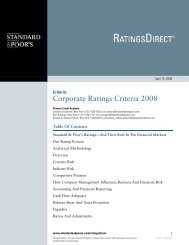European Infrastructure Finance Yearbook - Investing In Bonds ...
European Infrastructure Finance Yearbook - Investing In Bonds ...
European Infrastructure Finance Yearbook - Investing In Bonds ...
Create successful ePaper yourself
Turn your PDF publications into a flip-book with our unique Google optimized e-Paper software.
PROJECT FINANCE/PUBLIC-PRIVATE PARTNERSHIPS<br />
98 ■ NOVEMBER 2007<br />
resource sufficiency throughout the debt tenor. <strong>In</strong><br />
many cases, such as wind, where the assessment<br />
can be highly complex, we may require two<br />
surveys to get sufficient comfort. Just as with IE<br />
technical reports, a project striving for<br />
investment-grade and high speculative-grade<br />
ratings will require a strong resource-assessment<br />
report. However, given the potential for<br />
uncertainty in many resource assessments,<br />
stronger ratings are likely to require either more<br />
than one IE resource assessment, geographic<br />
diversity, or robust liquidity features to meet debtrepayment<br />
obligations if the resource does not<br />
perform as expected.<br />
Competitive market exposure<br />
A project’s competitive position within its peer<br />
group is a principal credit determinant, even if the<br />
project has contractually-based cash flow.<br />
Analysis of the competitive market position<br />
focuses on the following factors:<br />
• <strong>In</strong>dustry fundamentals<br />
• Commodity price risk<br />
• Supply and cost risk<br />
• Regulatory risk<br />
• Outlook for demand<br />
• Foreign exchange exposure<br />
• The project‘s source of competitive<br />
advantage<br />
• Potential for new entrants or disruptive<br />
technologies<br />
Given that many projects produce a commodity<br />
such as electricity, ore, oil or gas, or some form of<br />
transport, low-cost production relative to the<br />
market characterizes many investment-grade<br />
ratings. High costs relative to an average market<br />
price in the absence of mitigating circumstances<br />
will almost always place lenders at risk; but<br />
competitive position is only one element of<br />
market risk. The demand for a project’s output<br />
can change over time (seasonality or commodity<br />
cycles), and sometimes dramatically, resulting in<br />
low clearing prices. The reasons for demand<br />
change are many, and usually hard to predict.<br />
Any of the following can make a project more or<br />
less competitive:<br />
• New products<br />
• Changing customer priorities<br />
• Cheaper substitutes<br />
• Technological change<br />
• Global economic and trade developments<br />
STANDARD & POOR’S EUROPEAN INFRASTRUCTURE FINANCE YEARBOOK<br />
Experience has shown, however, that offtake<br />
contracts providing stable revenues or that limit<br />
costs, or both, may not be enough to mitigate<br />
adverse market situations. As an example,<br />
independent power producers in California had to<br />
restructure parts of fixed-price offtake agreements<br />
when the utilities there came under severe<br />
financial pressure in 2000 and 2001. Hence,<br />
market risk can potentially take on greater<br />
importance than the legal profile of, and security<br />
underlying, a project. Conversely, if a project<br />
provides a strategic input that has few, if any,<br />
substitutes, there will be stronger economic<br />
incentives for the purchaser to maintain a viable<br />
relationship with the project.<br />
Counterparty exposure<br />
The strength of a project financing rests on the<br />
project’s ability to generate stable cash flow as<br />
well as on its general contractual framework, but<br />
much of a project’s strength comes from<br />
contractual participation of outside parties in the<br />
establishment and operation of the project<br />
structure. This participation raises questions<br />
about the strength and reliability of such<br />
participants. The traditional counterparties to<br />
projects have included raw-material suppliers,<br />
principal offtake purchasers, and EPC<br />
contractors. Even a sponsor becomes a source of<br />
counterparty risk if it provides the equity during<br />
construction or after the project has exhausted its<br />
debt funding.<br />
Other important counterparties to a project can<br />
include:<br />
• Providers of LOCs and surety bonds;<br />
• Parties to interest rate and currency swaps;<br />
• Buyers and sellers of hedging agreements<br />
and other derivative products;<br />
• Marketing agents;<br />
• Political risk guarantors; and<br />
• Government entities.<br />
Because projects have taken on increasingly<br />
complex structures, a counterparty’s failure can<br />
put a project’s viability at risk.<br />
Standard & Poor’s generally will not rate a<br />
project higher than the lowest rated entity (e.g.,<br />
the offtaker) that is crucial to project<br />
performance, unless that entity may be easily<br />
replaced, notwithstanding its insolvency or failure<br />
to perform. Moreover, the transaction rating may



